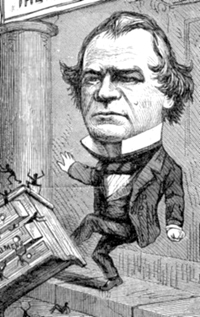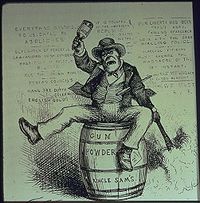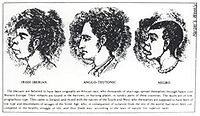
Harper's Weekly
Encyclopedia

United States
The United States of America is a federal constitutional republic comprising fifty states and a federal district...
political magazine
Magazine
Magazines, periodicals, glossies or serials are publications, generally published on a regular schedule, containing a variety of articles. They are generally financed by advertising, by a purchase price, by pre-paid magazine subscriptions, or all three...
based in New York City
New York City
New York is the most populous city in the United States and the center of the New York Metropolitan Area, one of the most populous metropolitan areas in the world. New York exerts a significant impact upon global commerce, finance, media, art, fashion, research, technology, education, and...
. Published by Harper & Brothers
Harper & Brothers
Harper is an American publishing house, the flagship imprint of global publisher HarperCollins.-History:James Harper and his brother John, printers by training, started their book publishing business J. & J. Harper in 1817. Their two brothers, Joseph Wesley Harper and Fletcher Harper, joined them...
from 1857 until 1916, it featured foreign and domestic news, fiction, essays on many subjects, and humor. During its most influential period it was the forum of the political cartoonist Thomas Nast
Thomas Nast
Thomas Nast was a German-born American caricaturist and editorial cartoonist who is considered to be the "Father of the American Cartoon". He was the scourge of Boss Tweed and the Tammany Hall machine...
.
Inception

Illustrated London News
The Illustrated London News was the world's first illustrated weekly newspaper; the first issue appeared on Saturday 14 May 1842. It was published weekly until 1971 and then increasingly less frequently until publication ceased in 2003.-History:...
, Fletcher began publishing Harper’s Monthly in 1850. The publication was more intent on publishing established authors such as Charles Dickens
Charles Dickens
Charles John Huffam Dickens was an English novelist, generally considered the greatest of the Victorian period. Dickens enjoyed a wider popularity and fame than had any previous author during his lifetime, and he remains popular, having been responsible for some of English literature's most iconic...
and William Makepeace Thackeray
William Makepeace Thackeray
William Makepeace Thackeray was an English novelist of the 19th century. He was famous for his satirical works, particularly Vanity Fair, a panoramic portrait of English society.-Biography:...
, but was a great enough success to begin publishing the Harper’s Weekly in 1857.
By 1860 the Weekly’s circulation had reached 200,000. Illustrations were an important part of the Weekly’s content, and it developed a reputation for employing some of the most renowned illustrators, notably Winslow Homer
Winslow Homer
Winslow Homer was an American landscape painter and printmaker, best known for his marine subjects. He is considered one of the foremost painters in 19th century America and a preeminent figure in American art....
, Granville Perkins
Granville Perkins
Granville Perkins . Born October 16, 1830 in Baltimore, Maryland, was an American artist and illustrator.- External links :* http://www.vallejogallery.com/artist.php?name=Granville_Perkins&id=134* http://granvilleperkins.com...
and Livingston Hopkins
Livingston Hopkins
Livingston York Yourtee "Hop" Hopkins was an American cartoonist who became a major Australian cartoonist during the time of the Federation of Australia.- Early life in the USA :...
. Among its recurring features were the political cartoons of Thomas Nast who was recruited in 1862 and would remain with the Weekly for more than 20 years. Nast was a feared caricaturist, considered by some the father of American political cartooning. He was the originator of the use of animals to represent the political parties—the Democrats' donkey and the Republicans' elephant—as well as the familiar character of Santa Claus.
Around the Civil War

Slavery
Slavery is a system under which people are treated as property to be bought and sold, and are forced to work. Slaves can be held against their will from the time of their capture, purchase or birth, and deprived of the right to leave, to refuse to work, or to demand compensation...
. For this it was called by the more hawkish publications “Harper’s Weakly”. The Weekly supported the Stephen A. Douglas
Stephen A. Douglas
Stephen Arnold Douglas was an American politician from the western state of Illinois, and was the Northern Democratic Party nominee for President in 1860. He lost to the Republican Party's candidate, Abraham Lincoln, whom he had defeated two years earlier in a Senate contest following a famed...
presidential campaign against Abraham Lincoln
Abraham Lincoln
Abraham Lincoln was the 16th President of the United States, serving from March 1861 until his assassination in April 1865. He successfully led his country through a great constitutional, military and moral crisis – the American Civil War – preserving the Union, while ending slavery, and...
, but as the American Civil War
American Civil War
The American Civil War was a civil war fought in the United States of America. In response to the election of Abraham Lincoln as President of the United States, 11 southern slave states declared their secession from the United States and formed the Confederate States of America ; the other 25...
broke out, Lincoln and the Union received full and loyal support of the publication. Arguably, some of the most important articles and illustrations came from the Weekly’s reporting on the war. Besides renderings by Homer and Nast, Harpers also published illustrations by Theodore R. Davis
Theodore R. Davis
Theodore R. Davis was a 19th-century American artist, who made numerous drawings of significant military and political events during the American Civil War and its aftermath....
, Henry Mosler
Henry Mosler
Henry Mosler , United States artist, was born in Tropplowitz, Silesia and moved with his family to New York when he was 8...
, and the brothers Alfred Waud
Alfred Waud
Alfred Rudolph Waud was an American artist and illustrator, born in London, England. He is most notable for the sketches he made as an artist correspondent during the American Civil War.-Early career:...
and William Waud
William Waud
William Waud was an English born architect and illustrator, notable for the sketches he made as an artist correspondent during the American Civil War.-Career:...
.
"President maker"


Ulysses S. Grant
Ulysses S. Grant was the 18th President of the United States as well as military commander during the Civil War and post-war Reconstruction periods. Under Grant's command, the Union Army defeated the Confederate military and ended the Confederate States of America...
in 1868 and 1872. In the 1870s, cartoonist Thomas Nast began an aggressive campaign in the journal against the corrupt New York political leader William “Boss” Tweed. Nast turned down a $500,000 bribe to end his attack, and eventually Tweed was arrested in 1873 and convicted of fraud. Nast and the Weekly also played an important part in securing Rutherford B. Hayes
Rutherford B. Hayes
Rutherford Birchard Hayes was the 19th President of the United States . As president, he oversaw the end of Reconstruction and the United States' entry into the Second Industrial Revolution...
’ 1876 presidential election. Later on Hayes remarked that Nast was "the most powerful, single-handed aid [he] had".

Grover Cleveland
Stephen Grover Cleveland was the 22nd and 24th president of the United States. Cleveland is the only president to serve two non-consecutive terms and therefore is the only individual to be counted twice in the numbering of the presidents...
for president. In doing so, Nast helped Cleveland become the first Democratic president since 1856. In the words of the artist's grandson, Thomas Nast St Hill, "it was generally conceded that Nast's support won Cleveland the small margin by which he was elected. In this his last national political campaign, Nast had, in fact, 'made a president.'" Nevertheless, changing editorial policies at the journal since the death of Fletcher Harper in 1877 had placed constraints on Nast, and his contributions became less frequent.
Nast's final contribution to Harper's Weekly was his Christmas illustration in December 1886. In the words of journalist Henry Watterson
Henry Watterson
Henry Watterson was a United States journalist who founded the Louisville Courier-Journal.He also served part of one term in the United States House of Representatives as a Democrat....
, "in quitting Harper's Weekly, Nast lost his forum: in losing him, Harper's Weekly lost its political importance".
After 1900, Harper’s Weekly devoted more print to political and social issues, and featured articles by some of the more prominent political figures of the time, such as Theodore Roosevelt
Theodore Roosevelt
Theodore "Teddy" Roosevelt was the 26th President of the United States . He is noted for his exuberant personality, range of interests and achievements, and his leadership of the Progressive Movement, as well as his "cowboy" persona and robust masculinity...
and Woodrow Wilson
Woodrow Wilson
Thomas Woodrow Wilson was the 28th President of the United States, from 1913 to 1921. A leader of the Progressive Movement, he served as President of Princeton University from 1902 to 1910, and then as the Governor of New Jersey from 1911 to 1913...
.
Harper's Weekly was absorbed by The Independent
The Independent (Boston)
The Independent published in Boston, Massachusetts, was a weekly newspaper devoted to politics, social and economic tendencies, history, literature, and the arts. It was published from 1848 to 1928, when it merged with The Outlook....
(New York; later Boston) in 1916, which in turn merged with The Outlook
The Outlook (New York)
The Outlook was a weekly magazine, published in New York City.-History:In 1900, the ranking weekly journals of news and opinion were The Independent , The Nation , the Outlook , and in a different class or with a different emphasis, The Literary Digest .-Notable contributors:*Theodore Roosevelt...
in 1928.
In the mid-1970s Harper's Magazine used the Harper's Weekly title for a spinoff publication. Actually a biweekly for most of its run, the revived Harper's Weekly depended on contributions from readers for much of its content.
External links
- Virginia Civil War Archive - online images including illustrations produced for the Harper's Weekly during 1861-1865 and which relate specifically to the Commonwealth of Virginia's involvement in the Civil War.
- Access for Issues 1861-1865 via sonofthesouth.net

